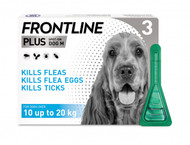Solving Flea & Tick Problems
Posted by Geoff Watson on 17th Feb 2016
Browse all flea treatments for dogs or flea treatments for cats and rabbits.
The problem ?
Millions of pounds are spent every year on insecticidal drops which apparently do not work although they are medicines fully licensed with governments throughout the world.
What are the ingredients ?
The most popular drops contain PERMETHRIN (eg EASIDROP) , FIPRONIL (eg FIPNIL or FRONTLINE) or IMIDACLOPRID ( eg ADVANTAGE) in special formulations designed to spread rapidly throughout the coat. They are not intended to dry rapidly and should be allowed to dry before allowing any contact with furnishings etc and may leave a slight residue on coat or skin.
Permethrin products are for use only on dogs, Fipronil is suitable for dogs and cats whilst Imidacloprid is available for dogs, cats and pet rabbits. PERMETHRIN products have a dual action and both repel and kill fleas and ticks.
Do they always work ?
YES– They will kill all adult fleas on the animal when used as directed. PERMETHRIN is also highly effective against ticks, FIPRONIL less so and IMIDACLOPRID completely ineffective against ticks.
Is this really true ?
YES– but unfortunately only a small proportion of the flea population (estimated at around 5%) are actually on the animal at any time and by the time these are noticed millions of flea eggs will have been shed and hatch out over the following months. These “new” fleas are attracted by vibration and leap onto passing animals (or people) to feed. This gives the impression that the flea treatment in use has failed.
Is it worth using a household flea spray as well ?
YES- Thorough use of one throughout the home is recommended by all manufacturers of flea drops. Most good environmental sprays such as INDOREX, ACCLAIM or STAY-KIL contain PERMETHRIN or similar insecticides to kill fleas and a “growth regulator” to stop the flea eggs hatching for up to 12 months.
So if we use “flea drops” on the pet AND a household spray will this definitely solve the problem ?
Not entirely– Fleas go through a “pupa” stage which insecticidal sprays cannot kill so these can still develop and re-infect pets for some time.
What will kill flea pupae then ?
The only products certain to kill pupae work by “smothering” them with silicone. Suitable products are SKOOSH, DURAMITEX PLUS (marketed for avians) or BOB MARTIN CLEAR Flea & Tick Spray. These products are insecticide-free and inert and therefore very safe but may leave slippery surfaces on floors etc where they have been used. They may also be sprayed on pets but have only a very short duration of action so repeated applications are necessary.
Total flea control is not easy and fleas have survived throughout the ages despite all efforts to exterminate them.
Is there anything else to do ?
Regular use of the vacuum cleaner keeps down the level of contamination and the warmth and vibration helps pupae develop faster into more vulnerable stages.
Cat fleas (the most common ones on both dogs and cats ) carry Dipylidium worm larvae which infect pets when the fleas are swallowed during grooming. Effective worming with a product containing PRAZIQUANTEL ( eg EASIMAX, DRONTAL or PRAZITEL) is essential.
Why is my pet still scratching now we have finally got rid of all the fleas ?
Pets can develop an allergy to flea dust which may persist after all the flea have gone. In severe cases steroids may be prescribed to control the itching.

